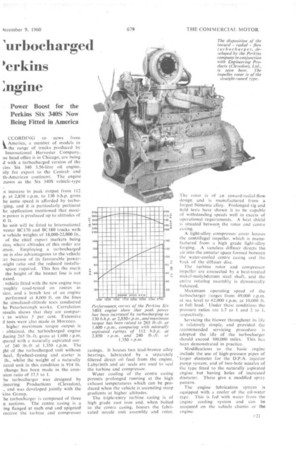lurbochartred 'erkins :ngine
Page 57

If you've noticed an error in this article please click here to report it so we can fix it.
CCOR DING to news from America, a number of models in
the range of trucks produced by International Harvester Company, Ise head office is in Chicago, are being d with a turbocharged version of the (ins Six 340 5.56-litre oil engine, nly for export to the Centraland th-American continent. The engine ,nown as the Six 340S vehicle-type n increase in peak output from 112 p. at 2,850 r.p.m. to 130 b.h.p. gross he same speed is afforded by turbo-ging, and it is particularly pertinent he application mentioned that maxin power is produced up to altitudes of 0 ft.
he unit will be fitted to International vester BC170 and BC180 trucks with ;s vehicle weights of 18,000-22,000 lb., of the chief export markets being deo where altitudes of this order are tmon. Employing a turbocharged me is also advantageous to the vehicle :er because of its favourable powerveight ratio and the reduced installaspace ,required. This has the merit the height of the bonnet lint is not eased.
. vehicle fitted with the new engine was -oughly road-tested on routes in dco, and a bench test of an engine performed at 8,000 ft. on the lines he simulated-altitude tests conducted he Peterborough works. Correlation results shows that they are compar: to within 5 per cent. Extensive d tests were also made in Morocco. . higher maximum torque output is , obtained, the turbocharged engine clueing 265 lb.-ft. gross at 1.600 r.p.m. 'pared with a naturally aspirated outof 240 lb.-ft at 1,350 r.p.m. The ;ht of the turbocharged unit without ?heel, flywheel-casing and starter is lb., whilst the weight of a naturally rated unit in this condition is 914 lb. change has been made in the com;sion ratio of 17.5 to 1.
he turbocharger was designed by ;ineering Productions (Clevedon), and was developed jointly with the dos Group.
he turbocharger is composed of three n sections. The centre casing is a ing flanged at each end and spigoted receive the turbine and compressor
casings. It houses two lead-bronze alloy bearings, lubricated by a separately filtered direct oil feed from the engine, Labyrinth and air seals are used to seal the turbine and compressor.
Water cooling of the centre casing permits prolonged running at the high exhaust temperatures which can be produced when the vehicle is ascending steep gradients at higher altitudes.
The triple-entry turbine casing is of high grade cast iron and, when bolted to the centre casing, houses the fabricated nozzle unit assembly and rotor.
The rotor is of an inward-radial-flow design and is manufactured from a forged Nimonic alloy. Prolonged rig and field tests have shown it to be capable of withstanding speeds well in excess of operational requirements. A heat shield is situated between the rotor and centre casing.:
A light-alloy compressor cover houses the centrifugal impeller, which is manufactured from a high grade light-alloy forging. A vaneless diffuser directs the air into the annular space formed between the water-cooled centre casing and the back of the diffuser disc.
The turbine rotor and compressor impeller are connected by a heat-treated nickel-molybdenum steel shaft, and the entire rotating assembly is dynamically balanced.
Maximum operating speed of the turbocharger ranges from 49,000 r.p.m. at sea level to 62,000 r.p.m. at 10,000 ft. at full load. Under these conditions the pressure ratios are 1.7 to 1 and 2 to 1, respectively.
Servicing the blower throughout its life . is relatively simple, and provided the recommended servicing procedure i5 adopted the life of the turbocharger should exceed 100,000 miles. This has been demonstrated in practice.
Modifications to the basic engine include the use of high-pressure pipes of larger diameter for the D.P.A. injector punjp system, and of two-hole nozzles of the type fitted to the naturally aspirated engine but having holes of increased diameter. These give a modified spray pattern.
The engine lubrication system is equipped with a cooler of the oil-water type. This is fed with water from the engine cooling system and can he mounted on the vehicle chassis or the engine.
























































































































